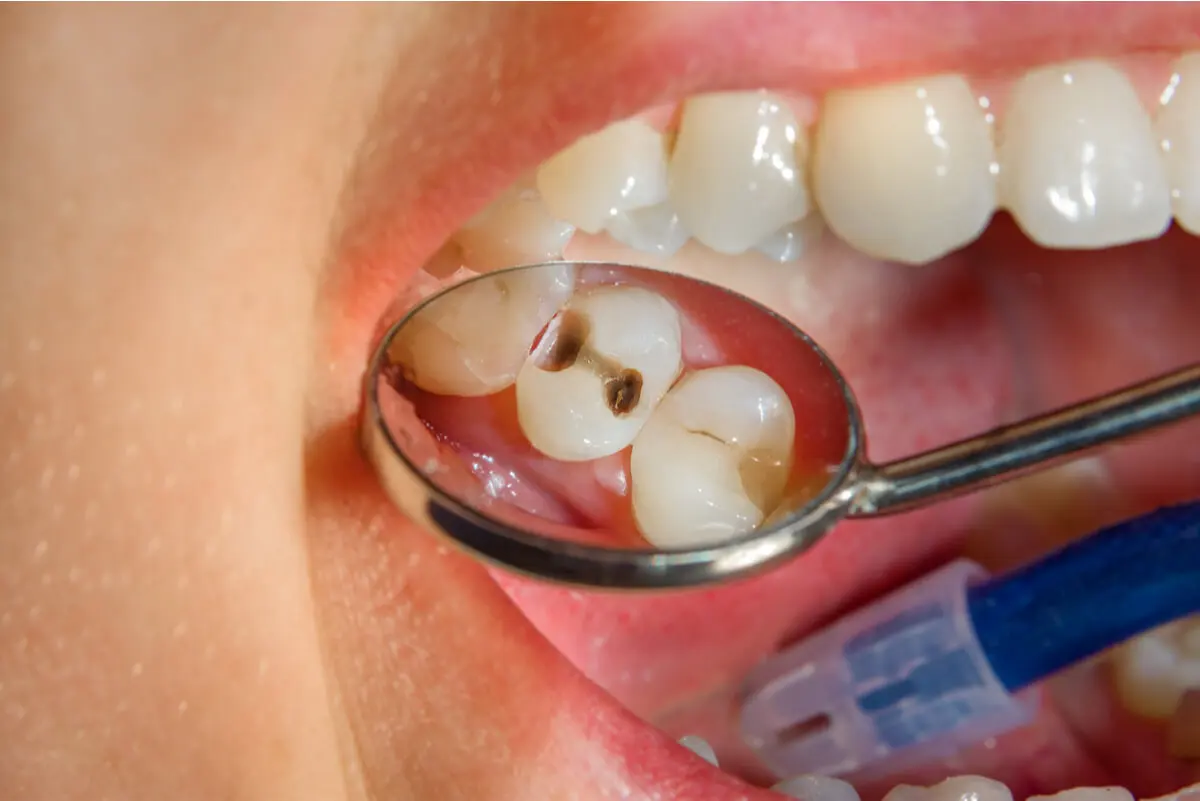Dental Filling: Types and Everything You Need to Know


Written and verified by the dentist Vanesa Evangelina Buffa
A dental filling is one of the most common dental treatments. It’s the procedure performed to restore the loss of hard tissue in the teeth when they’ve been destroyed by cavities or other conditions.
The presence of hollows and cavities on the dental structures causes esthetic and functional problems in the mouth. In addition, these recesses, which are difficult to clean, favor the accumulation of bacteria that continue with the destruction of the teeth.
To prevent the loss of dental tissues, eliminate the disease, and restore the anatomy, function, and appearance of the teeth, it’s necessary to get a dental filling. In this article, we’ll tell you what this procedure is, when it is performed and what materials are used.
What is a dental filling?
A dental filling is also simply known as a “filling.” It’s the treatment applied to teeth when they’re affected by cavities or other diseases that generate a loss of hard tissues.
When this happens, a gap is produced. Through this procedure, the cavity is filled with a specific material that recomposes the damaged tooth. However, before this, the dental element is thoroughly cleaned, and the diseased areas are removed.
The objective of the filling is to restore the anatomy of the tooth. Thus, it’s possible for it to recover its shape, appearance, and even certain lost functions. As we will tell you later, there are different types of filling materials that are used in different situations. The dentist will choose the most suitable one for each case.
The procedure to perform a dental filling is quite simple and fast. In general, it takes no more than 20 to 30 minutes.

When is it necessary to get a dental filling?
The most common cause that leads people to require a dental filling is cavites. This condition is one of the most frequent worldwide and in all age groups.
It occurs because the bacteria in the mouth metabolize the carbohydrates in the diet and produce acids. This leads to demineralization and destruction of the hard tissues of the teeth.
Tooth decay in permanent teeth is the most common disorder; it’s estimated that 2 billion people suffer from it. In addition, about 520 million children suffer from decay in their baby teeth.
If cavities are not treated in a timely manner, the destructive process advances and deepens, which can affect the pulp. In these cases, a simple filling or dental filling will no longer be enough, and endodontics will be necessary.
However, there are other situations that may also require a dental filling. For example, the following:
- Tooth fractures.
- Old fillings in poor condition. If they have leaks or cavities underneath, it’s a good idea to have them replaced.
- Fissures, abrasions, or tooth wear without the presence of cavities, which need to be repaired.
- Esthetic alterations of shape, color, or position in anterior or posterior teeth. A filling can correct these defects and improve the appearance.
Types of dental fillings
When it comes to performing a dental filling, there are different factors that the dentist must consider in order to perform one type or another. The considerations are as follows:
- The affected tooth element
- The extent and size of the repair
- The location of the cavity
- The materials to be used
- The patient’s preferences
- The price
Depending on these aspects, the professional chooses the most convenient type of procedure for each case. Different techniques and materials can be used to restore tooth structure.
Depending on the size of the restoration, the filling or dental filling may be direct or indirect.
- Direct obturation: This is performed in the case of simple lesions in which the tooth wear is small, and most of the anatomy of the tooth is preserved. It’s performed in a single visit to the dentist’s office, where the dentist performs the entire treatment.
- Indirect obturation: This is the procedure of choice to treat larger lesions in which there is a great loss of dental tissue. In this case, more than one consultation is necessary since impressions are taken, and part of the restoration is performed in the dental laboratory.
Fillings can also be divided into different types, depending on the material used to fill the cavity. Here are the most commonly used products.
We think you may be interested in reading this, too: LED Teeth Whitening: Advantages, Disadvantages, and Care
Composite resin fillings or “composites”
Composite resins are one of the materials most commonly used today for fillings. This product achieves a very similar appearance to the tooth and has adequate strength, durability, and adhesion.
Composites are mainly used when a filling has to be made in the anterior sector, on the more visible front teeth. However, it’s also possible to use this material on molars, as it is capable of resisting masticatory forces very well.
Resin fillings adhere chemically to the tooth structure, giving them good support. In addition, when the teeth are worn down, it’s not necessary to remove extra tissue for placement, as is the case with amalgams.
This material is very easy to manipulate, and the dentist usually takes no more than 20 minutes to complete the procedure. It’s placed in small layers that are hardened with a special light until the filling is complete.
Resins can be used both directly – as we’ve already mentioned – or to make indirect repairs. In addition, they’re not only used for filling cavities, but are also useful for repairing worn, chipped, or fractured teeth.
A disadvantage of resin fillings is that they are less durable than amalgam fillings. They also don’t have the same strength as amalgam and can stain and pigment over time. They are now widely used, and the results are very satisfactory.
Cements fillings
Dental cements are widely used in dentistry. Many times these composites are used to fill cavities and act as temporary or definitive fillings.
- Temporary filling cement: These are used to fill cavities on a temporary basis. Therefore, they remain in the tooth for a few days or months. They’re characterized by their rapid hardening and for being easy to remove at the time of replacing them with the definitive one.
- Definitive cements: These are similar to temporary fillings, but much more durable. Vitreous ionomers are used to fill certain cavities, especially in the temporary molars of children.
Direct silver amalgam fillings
An amalgam dental filling is characterized as a durable, strong, and economical filling. This material withstands chewing forces very well, which is why it’s only used in the back of the mouth.
Due to its dark coloration, it’s not a material that is used in visible areas, such as the front teeth. In addition, over time, the material can stain tooth surfaces.
As mentioned above, the placement of amalgams requires more wear on the teeth. For this reason, and because of the esthetic advantages, it’s currently being replaced by resins.
Amalgam is an alloy of silver and mercury. The use of the latter component has led to a decrease in its use in dentistry.
In any case, you should know that very low doses of mercury are used in its production. Therefore, this dental material is not dangerous either for the patient or for the dentist who handles it.
Like this article? You may also like to read: 3 DIY Treatments to Remove Tartar from Your Teeth
Indirect gold fillings
Gold is an ancient dental filling material that, in some cases, is still in use. Its durability and strength are very high, but so is its cost.
Gold in teeth doesn’t corrode and can withstand chewing forces. In addition, some patients consider gold restorations to be aesthetic or to denote prestige.
Several office visits are required to fabricate this type of dental filling. After the teeth are worn down, it will be necessary to take a mold and send the filling to be fabricated in a dental laboratory.
A common problem they cause is that if the person has amalgam fillings in the mouth, a galvanic shock occurs. This is a physical phenomenon where two dissimilar metals and saliva interact, resulting in an electrical current that causes pain.
Indirect porcelain fillings
Porcelain inlays are an excellent option for filling teeth. This type of filling is made in a dental laboratory, using the measurements of each patient’s teeth. The piece obtained is then cemented in the carved tooth.
Their advantage is that they are very esthetic, resistant to stains, and have great durability. However, their disadvantage is their high cost.
The characteristics of dental filling materials
We’ve already told you about the main materials used to fill teeth. In order for these products to restore damage to teeth, they must meet certain characteristics:
- Abrasion resistance: The filling material must be able to withstand the friction and constant collision of the teeth with each other and with food, especially in the molar area. If this is not the case, the filling will wear out.
- Resistance to oral fluids: The filling must be able to withstand moisture, enzymes, and other components of saliva.
- Low thermal conductivity: Teeth are constantly exposed to hot and cold foods. The filling materials must be able to withstand thermal changes so as not to cause sensitivity.
- Correct sealing of cavities: This avoids spaces through which debris and bacteria can filter.
- Easy to handle: The dentist must be able to handle the filling material easily. In this way, it’s possible to fill the entire cavity and achieve esthetic reconstructions similar to natural teeth.
If the filling material meets the requirements we mentioned, it can be considered a good product for the dental filling.

How is a dental filling performed?
When performing a dental filling, the procedure varies depending on whether it’s a direct filling or an indirect restoration.
Direct filling
Direct fillings are the quickest and easiest to perform. The dentist completes the entire procedure in the dental office in a single visit.
- The first step is to apply local anesthesia to numb the area so that the patient does not feel pain. Then, the cavities are removed, and the tooth is cleaned using stones and burs with a turbine.
- Once the element is clean, the cavity is sealed with the chosen filling material. In some cases, it’s necessary to place adhesive systems that bond the product to the tooth surface.
- Resin fillings must be hardened using a special light. Amalgam fillings, on the other hand, are pressed against the tooth surface with special instruments.
- Once the filling is finished, the patient’s bite must be tested, and the excess material must be worn away. Finally, the filling is polished to make it smooth and shiny.
Process for indirect fillings
Indirect fillings require at least two dental office visits. The filling is fabricated in a dental laboratory.
- In the first visit, the dentist anesthetizes the mouth, removes the decay, and cleans the tooth as in a direct filling. He or she then takes an impression of the dentition to record the shape of the tooth being treated and the surrounding elements.
- This impression is sent to a prosthetic laboratory that will make the filling with the chosen material. Before the patient leaves, a temporary filling is placed to protect the tooth until the definitive restoration is ready.
- On the second visit, the temporary filling is removed, and the filling sent by the laboratory is placed. Its correct adjustment and adaptation are verified, and it’s permanently cemented into the tooth.
Avoiding the need for dental fillings
Getting a filling is a simple and convenient procedure. However, the best option is always to avoid the conditions that lead to this type of treatment.
To do this, you should maintain some simple habits that will reduce the risk of your teeth breaking. Brushing your teeth at least twice a day with fluoride toothpaste and flossing regularly will help you control plaque.
Taking care of your diet and visiting the dentist every six months for check-ups and cleanings are also important. With this basic care, you can avoid dental fillings and keep the ones you already have in your mouth in good condition.
All cited sources were thoroughly reviewed by our team to ensure their quality, reliability, currency, and validity. The bibliography of this article was considered reliable and of academic or scientific accuracy.
- Valdiviezo Falcones, R. A. (2022). Restauraciones estéticas en sector anterior con sistemas resinosos (Bachelor’s thesis, Universidad de Guayaquil. Facultad Piloto de Odontología).
- Perdigão, J., Araujo, E., Ramos, R. Q., Gomes, G., & Pizzolotto, L. (2021). Adhesive dentistry: Current concepts and clinical considerations. Journal of Esthetic and Restorative Dentistry, 33(1), 51-68.
- MERINO, G. J. L. (2019). Fundamentos para elegir una resina dental. Odontología Activa Revista Científica, 4(Esp), 57-64.
- Mourelle, P. M., Hernándezº, P. S., Vallejo, M. Z., & Meneses, D. R. (2016). Materiales y técnicas para incrustaciones dentales. Revista internacional de prótesis estomatológica, 18(1), 15-23.
- Raúl, C. R., Lina, M. R., & Andrés, G. B. (2020, October). INCRUSTACIONES METÁLICAS, UNA ALTERNATIVA PARA DIENTES CON GRAN PÉRDIDA CORONARIA. A PROPÓSITO DE 3 PACIENTES. In Estomatologia2020.
- Villamar Coello, E. J. (2018). Incrustaciones a base de resina compuesta como solución práctica a la escasa estética de una restauración de amalgama (Bachelor’s thesis, Universidad de Guayaquil. Facultad Piloto de Odontología).
- García Garcés, J. E. (2020). Amalgama dental uso y seguridad (Bachelor’s thesis, Universidad de Guayaquil. Facultad Piloto de Odontología).
- Lozano Diaz, C. I. (2021). Estudio de la microfiltración coronal utilizando tres materiales de obturación temporal. Revisión sistemática.
- Torres Yupanqui, J. C. (2022). Incrustación Inlay en paciente adulto con tratamiento de conductos.
This text is provided for informational purposes only and does not replace consultation with a professional. If in doubt, consult your specialist.








